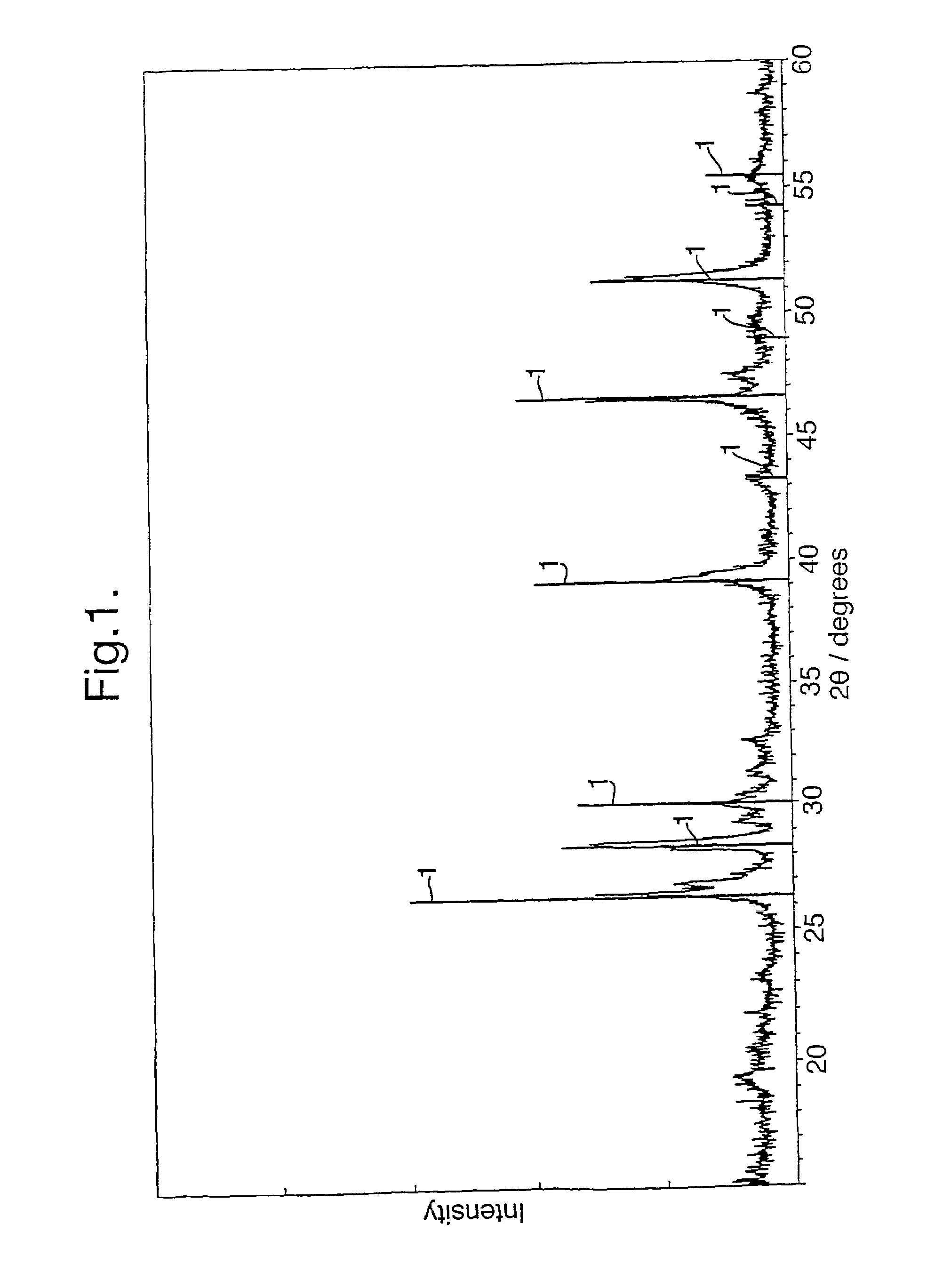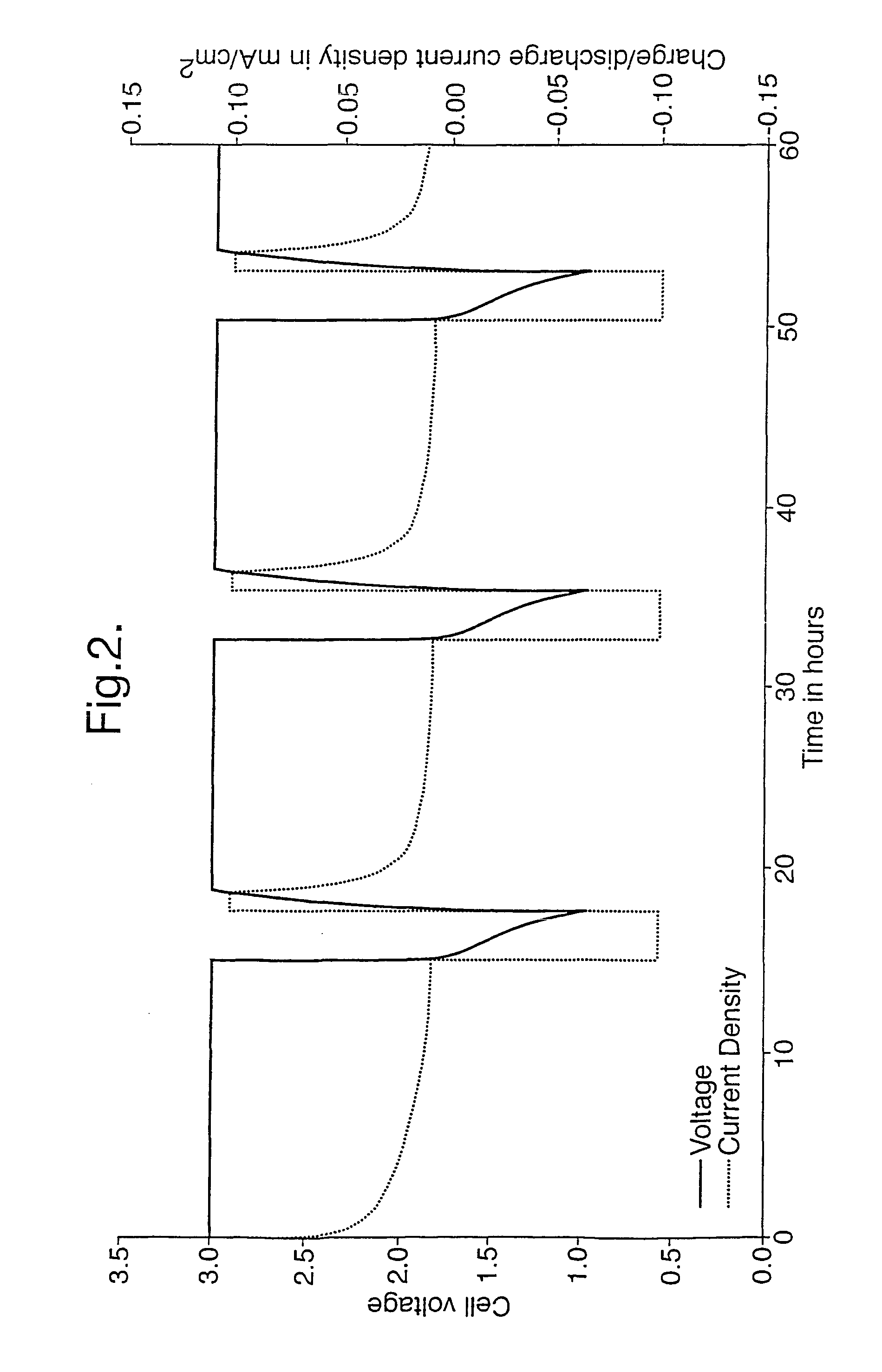Synthesis of lithium iron sulphides and their use as cathodes
a lithium iron sulphide and cathode technology, applied in the field of lithium metal rechargeable batteries, can solve the problems of limited use of lithium rechargeable batteries at present, sulphide cathode materials are not as attractive as oxides, and the use of lithium iron sulphides as cathode materials is now limited
- Summary
- Abstract
- Description
- Claims
- Application Information
AI Technical Summary
Problems solved by technology
Method used
Image
Examples
example 1
[0033]Li2S and FeS were reacted together in a molten salt solvent of lithium chloride, LiCl, at 650° C. for ca. 2 hours, under an argon atmosphere. After completion, the LiCl was removed by refluxing in pyridine for 8 hours. FIG. 1 shows an XRD trace of the product obtained. The vertical lines 1 represent the standard trace for pure Li2FeS2 taken from the JCPDS database. The main peaks are co-incident with and have similar relative intensities to these lines 1, indicating that the dominant product phase obtained was Li2FeS2. The remaining peaks correspond to small amounts of unreacted starting materials.
[0034]The product obtained was used to manufacture a cathode as described above. FIG. 2 illustrates three cycling curves which indicate that the cathode could be repeatedly charged and discharged. This demonstrates that the product was suitable for use as a cathode material for a lithium rechargeable battery.
example 2
[0035]Li2S and FeS were reacted together in a molten salt solvent of lithium bromide, LiBr, at 550° C. for ca. 2 hours, under an argon atmosphere. After completion, the LiBr was removed by refluxing in diethyl ether for 8 hours. FIG. 3 shows an XRD trace of the product obtained. The vertical lines 1 represent the standard trace for pure Li2FeS2 taken from the JCPDS database. The main peaks are co-incident with and have similar relative intensities to these lines 1, indicating that the dominant product phase obtained was Li2FeS2. The remaining peaks correspond to small amounts of unreacted starting materials.
example 3
[0036]Li2S and FeS were reacted together in a molten salt solvent of lithium iodide, Lil, at 450° C. for ca. 2 hours, under an argon atmosphere. After completion, the Lil was removed by refluxing in acetonitrile for 8 hours. FIG. 4 shows an XRD trace of the product obtained. The vertical lines 1 represent the standard trace for pure Li2FeS2 taken from the JCPDS database. The main peaks are co-incident with and have similar relative intensities to these lines 1, indicating that the dominant product phase obtained was Li2FeS2. The remaining peaks correspond to small amounts of unreacted starting materials.
[0037]The product obtained was used to manufacture a cathode as described above. FIG. 5 illustrates three cycling curves which indicate that the cathode could be repeatedly charged and discharged. This demonstrates that the product was suitable for use as a cathode material for a lithium rechargeable battery.
PUM
| Property | Measurement | Unit |
|---|---|---|
| temperatures | aaaaa | aaaaa |
| temperatures | aaaaa | aaaaa |
| temperatures | aaaaa | aaaaa |
Abstract
Description
Claims
Application Information
 Login to View More
Login to View More - R&D
- Intellectual Property
- Life Sciences
- Materials
- Tech Scout
- Unparalleled Data Quality
- Higher Quality Content
- 60% Fewer Hallucinations
Browse by: Latest US Patents, China's latest patents, Technical Efficacy Thesaurus, Application Domain, Technology Topic, Popular Technical Reports.
© 2025 PatSnap. All rights reserved.Legal|Privacy policy|Modern Slavery Act Transparency Statement|Sitemap|About US| Contact US: help@patsnap.com



